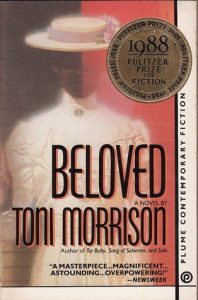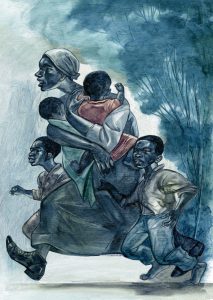 I’ve been pondering writing a new novel that illuminates a horrific period in my family’s heritage. As I re-read Toni Morrison’s Beloved, it became clear to me that her techniques of emotional withholding and surrealistic storytelling would be quite useful in telling the story that I’m tentatively calling A Mercy Upon Us.
I’ve been pondering writing a new novel that illuminates a horrific period in my family’s heritage. As I re-read Toni Morrison’s Beloved, it became clear to me that her techniques of emotional withholding and surrealistic storytelling would be quite useful in telling the story that I’m tentatively calling A Mercy Upon Us.
The verifiable family history I would use in my novel is the story of my grandfather’s parents. They were two young immigrants from Holland, with four children in tow, and one in the oven. They brought with them their elderly grandmother, to help with the children and the new baby about to be born. However, the only English speaker was the father. Shortly after arriving in this New World, the father contracted tuberculosis and died. The mother had just given birth, and alone, alienated, and bereft in this strange land, she sank into post-partum depression, and shortly thereafter committed suicide. The oldest child, Sue, assisted the elderly grandmother in adopting out the other children to families who gave them new names and new histories. Twenty-five years later, Sue went back and found each of the children, and told them who they really were, and where they came from. She gave them their true story – which was both a curse and a blessing. My grandfather may have never recovered from the knowledge that he was not who he had thought he had been, and seemed to carry it as a dark weight his whole life.
 Although this story has not a hint of magic about it (except perhaps the magic of memory), I found in Toni Morrison’s work a number of techniques that may help me to understand how to think through this book from the perspective of my narrator Sue. First, one technique I find quite useful is the way that Morrison describes events and persons through a lens that is unusual and lends a patina of strangeness to a scene, hinting just barely to her readers that all is not as it first appears. I could use this technique to give alternate versions of what happens, in a Rashomon type of multi-valent storytelling. For now, though, I think I’m going to just focus on Sue’s perspective, and let the story come out naturally as she tells it to the siblings she finds in her long quest to tell them the truth.
Although this story has not a hint of magic about it (except perhaps the magic of memory), I found in Toni Morrison’s work a number of techniques that may help me to understand how to think through this book from the perspective of my narrator Sue. First, one technique I find quite useful is the way that Morrison describes events and persons through a lens that is unusual and lends a patina of strangeness to a scene, hinting just barely to her readers that all is not as it first appears. I could use this technique to give alternate versions of what happens, in a Rashomon type of multi-valent storytelling. For now, though, I think I’m going to just focus on Sue’s perspective, and let the story come out naturally as she tells it to the siblings she finds in her long quest to tell them the truth.
In Morrison’s novel, the dead ghost of a child re-emerges into the lives of the main characters as a grown fully fleshed woman who has “willed” her way back into existence. At first, they do not know who she is, or what she represents in their lives. Morrison mirrors the characters’ lack of context for “Beloved” by providing an the initial introduction of Beloved as a character through poetic language that paints the situation as strange and imaginatively unreal. No one reacts to the scene, but the description is strange and compelling:
A fully dressed woman walked out of the water. She barely gained the dry bank of the stream before she sat down and leaned against a mulberry tree. All day and all night she sat there, her head resting on the trunk in a position abandoned enough to crack the brim in her straw hat. Everything hurt but her lungs most of all. Sopping wet and breathing shallow she spent those hours trying to negotiate the weight of her eyeballs. …. She had new skin, lineless and smooth, including the knuckles of her hands…. four times the woman drank from the speckled tin cup as though she had crossed a desert. (Morrison 50)
 The critical elements here are the indications that this “woman” is not of our world: her lungs hurt, her eyeballs have an unusual weight, and she has new skin. Finally, she has just “crossed a desert.” All of these mentions tell the reader that this woman is experiencing reality in a different way than the other characters. Of course, after you’ve read the book once, you recognize the metaphors of birthing and of new life in the world. However, at first read, these hints simply give her reality a radically different angle, an unusual and poetic perspective. The hints reverberate and pile up though, over time, until the weight of what they might mean is inescapable.
The critical elements here are the indications that this “woman” is not of our world: her lungs hurt, her eyeballs have an unusual weight, and she has new skin. Finally, she has just “crossed a desert.” All of these mentions tell the reader that this woman is experiencing reality in a different way than the other characters. Of course, after you’ve read the book once, you recognize the metaphors of birthing and of new life in the world. However, at first read, these hints simply give her reality a radically different angle, an unusual and poetic perspective. The hints reverberate and pile up though, over time, until the weight of what they might mean is inescapable.
In the same manner, I believe that the mother’s suicide in my novel can be more powerful if I don’t actually say it by name, but instead allow it to be hinted at and illuminated by metaphor until the possibility of it, and then the reality of it becomes something heavy and inescapable in the reader’s mind – an overwhelming radical change that is referenced only glancingly by the other characters, but gradually insists on its own reality, much as Beloved gradually insists on her reality in the lives of the characters in Morrison’s work. Metaphor and oblique references are critical tools to invoke an alternate story, or to hint at a story that can’t be told overtly.
If I need to hint at the story, it’s also necessary to show how my other characters are gradually informed. Specifically, I think withholding the actual story from my readers, and allowing it to come out gradually as Sue tells it to other people, is a technique worth exploring. Morrison does this adroitly. For example, it is absolutely lovely to see how she has her characters interact with “Beloved.” They field seemingly innocuous questions and discussion, and then Morrison allows the realization of the import of those questions to land later, at the end of the discussion, so that the true meaning of that conversation reverberates backwards through the story. Here’s one instance of this technique: “Now she noticed something more. The questions Beloved asked: ‘Where are your diamonds?’ ‘Your woman she never fix up your hair?’ And most perplexing: Tell me your earrings. How did she know?” (Morrison 63). The cold realization of something unnatural – knowledge ungained from the other characters – hits the characters after the reader has already realized something is strange about the woman’s knowledge.
Finally, Morrison brings the “alternate” story (or the backstory) into her character’s lives through visceral experiences that are inserted into a present narrative. She forces the story into the main narrative by taking the hints much further, until their import is inescapable. Here’s a later scene that shows “Beloved” demonstrating her story – and her ghostly reality – to the other characters:
Beloved, inserting a thumb in her mouth along with the forefinger, pulled out a back tooth. There was hardly any blood…. Beloved looked at the tooth and thought, This is it. Next would be her arm, her hand, a toe. Pieces of her would drop maybe one at a time, maybe all at once. Or on one of those mornings…she would fly apart. It is difficult keeping her head on her neck, her legs attached to her hips when she is by herself. (Morrison 133)
Again, in this scene, Morrison does not make the back-story of “Beloved” into something unreal or ghostly, but grounds in realistically-described moments of experience that the other characters can actually sense and feel and see. Her character’s tooth removal seems very realistic and very sensory. Therefore, when her character ponders her own unreality, and the difficulty of living as a “ghost” in the human world, the reader can suspend disbelief and travel with her narrative, because the previous moments were firmly grounded. Instead of being caught in abstractions, the reader starts from an anchor point that is firmly grounded in the everyday world. What Morrison does so amazingly well is to make the magic real to the characters, and thus, to the readers.
 The realistically described experiences of “Beloved” thus brings the realization of the back-story (or alternate story) home to her readers with a powerful punch. Much later in the book, after all of these hints and experiences have slowly collected like drops wearing down the disbelief of her other characters, Morrison finally brings a waterfall of realization. Here’s where Morrison brings the truth home: The “sweet conviction” in her eyes “almost made him wonder if it had happened at all, eighteen years ago, that while he and Baby Suggs were looking the wrong way, a pretty little slavegirl had recognized a hat, and split to the woodshed to kill her children” (Morrison 158). This is the moment that Morrison brings out the main pivotal moment in the backstory. Because of her consistent buildup of this story, the description lands with a satisfying wallop of pain.
The realistically described experiences of “Beloved” thus brings the realization of the back-story (or alternate story) home to her readers with a powerful punch. Much later in the book, after all of these hints and experiences have slowly collected like drops wearing down the disbelief of her other characters, Morrison finally brings a waterfall of realization. Here’s where Morrison brings the truth home: The “sweet conviction” in her eyes “almost made him wonder if it had happened at all, eighteen years ago, that while he and Baby Suggs were looking the wrong way, a pretty little slavegirl had recognized a hat, and split to the woodshed to kill her children” (Morrison 158). This is the moment that Morrison brings out the main pivotal moment in the backstory. Because of her consistent buildup of this story, the description lands with a satisfying wallop of pain.
In Morrison’s techniques of metaphorical description, backstory hints, and visceral experience, I see some tools I can use in gradually revealing the “truth” of my story Mercy Upon Us. I hope that when I’m able to take the time to write that novel that I’m able to effectively use these techniques to communicate as powerfully as Morrison did in Beloved.
A literary update from NedNote.com
Readers can find my books at these bookstores:
WORKS CITED
Morrison, Toni. Beloved. New York: Penguin Group, 1988.





